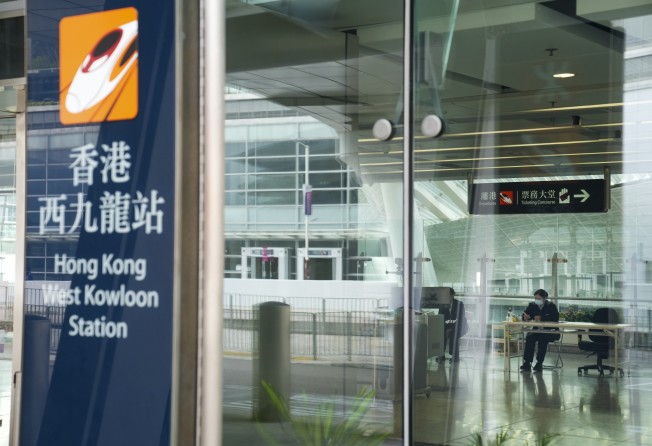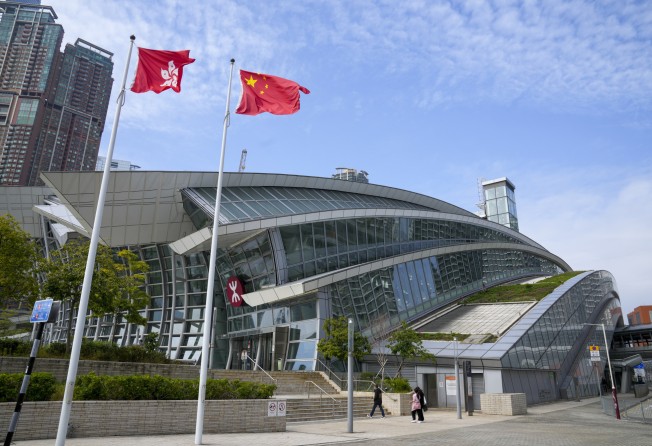
10,000 daily tickets go on sale for high-speed rail link between Hong Kong and mainland China
- Recently built route offers new stops at Dongguan, Dongguan South and Guangzhou East
- Thirty-nine trains will head north each day, including six to new Guangzhou East station

As many as 10,000 tickets will be available each day for the high-speed railway connecting Hong Kong and mainland China, although the number may increase after assessing demand, the city’s transport chief has said.
Tickets went on sale on Thursday for the nearly 80 trains that will be travelling daily along the line, which suspended operation of its Hong Kong leg three years ago when the pandemic erupted.
A recently built route offers new stops at Dongguan, Dongguan South and Guangzhou East, in addition to the existing ones along the line to Guangzhou South.

Secretary for Transport and Logistics Lam Sai-hung said the number of tickets for trains heading north would be limited to 5,000 for now.
“We will review the operation flow and tourist demand soon after reopening to see if we need to sell more tickets and add more trains, including long-haul ones,” he said.
“There is always demand for trains heading to Guangzhou, and we believe the Guangzhou East station will be attractive to travellers. There are also a lot of new attractions, such as the M+ museum and Palace Museum, near the West Kowloon terminus, and we believe tourists will like them.”
Lam said it would be crucial for service to resume to Shenzhen North and Guangzhou South stations, as these two original stops were important links to the wider mainland express-rail network.
Thirty-nine trains will head north, including six going to the new Guangzhou East station, and 38 to Hong Kong, according to railway operator the MTR Corporation. This is about half of pre-pandemic levels, when about 70 short- and 13 long-haul journeys were available each way daily.
The railway provider said more than 3,000 north-bound tickets for January 15, or 60 per cent of the daily limited, had been sold. Bookings for trains between January 15 and 26 heading to Guangzhou South, Guangzhou East, Shenzhen North and Futian were still available, it added.
A first-class ticket for the train going from West Kowloon to Guangzhou East on Sunday costs 216 yuan (US$28), while a second-class ticket is priced at 187 yuan.
The 26km-long (16 miles) city section of the Guangzhou-Shenzhen-Hong Kong Express Rail Link was in service for about 16 months before it closed in late January 2020 because of the pandemic. The trains ran from the West Kowloon terminus through to Shenzhen and south Guangzhou.
“We believe 10,000 tickets [for both directions] per day at the preliminary stage are adequate to cope with the demand considering traffic since the border reopened,” said Jeny Yeung Mei-chun, the MTR Corp’s Hong Kong transport services director, noting tens of thousands of passengers had travelled in pre-pandemic times.
There was no definite timetable to resume long-haul destinations at the moment, but the MTR Corp would closely monitor the situation and make changes, she added.

Passengers can buy tickets for the next 15 days via various platforms, including the mainland’s 12306 website and its mobile app, as well as at the West Kowloon terminus, which reopened on Thursday afternoon.
Outbound passengers must provide a negative result for a Covid-19 polymerase chain reaction (PCR) test taken within 48 hours of departure, and complete the mainland’s health declaration form. Passengers must also wear a mask at all times, but flammable disinfectants such as hand sanitiser are not allowed.
Hong Kong on Thursday recorded 9,208 Covid-19 infections, 292 of which were imported and 74 related deaths. The city’s tally stands at 2,809,447 cases and 12,622 fatalities.
Meanwhile, Lam did not make it clear whether the historic cross-border intercity through-train services linking the city’s Hung Hom station with Guangzhou East would be axed. The MTR Corp said services would continue to be suspended in the short-run as the high-speed rail offered a shorter travel duration to passengers.
“Guangzhou East is located near a traditional business area, and used to be served by the intercity through-train service. With the high-speed rail link, people who want to go directly there can do so now,” Lam said.
“We will review the new services offered by the high-speed railway before making a final decision on the future of the intercity through-train services.”

The West Kowloon terminus will be the latest border control point to reopen after seven others resumed operations following the return of quarantine-free travel between Hong Kong and the mainland last Sunday. The mainland also started issuing visas to international travellers for quarantine-free visits for the first time in three years on the same day.
Travellers crossing the border using the West Kowloon terminus are not subject to a daily quota. As long as they can buy a ticket, they are free to travel.
Authorities at present allow 50,000 people a day to travel in either direction at the land crossings at Shenzhen Bay, Man Kam To and Lok Ma Chau railway station.
Secretary for Security Chris Tang Ping-keung said about 520,000 slots in the travel quota, or one-sixth of the amount for two months, had so far been booked and authorities were reviewing whether more should be provided for special days, such as before and during the Lunar New Year holiday, when many spots had been snapped up.
A Post check revealed that the 35,000 and 10,000 daily quota for the Lok Ma Chau and Shenzhen port checkpoints, respectively, were full on January 20 – two days before the first day of the Lunar New Year holiday – while only nighttime slots were available on January 18 and 19 for Lok Ma Chau station.
For the Man Kam To rail line checkpoint, which has a daily quota of 5,000, there are still time slots available on all dates.
Demand for private cars crossing the border via the Hong Kong-Zhuhai-Macau Bridge is high, with only four time slots available out of the 18 across six days from January 18 to 23. Currently, there is a 1,000 daily quota for each way.
Lam Wai-keung, chairman of the Federation of Railway Trade Unions, said the MTR had started trials with 11 to 12 short-haul trains without passengers every day since Sunday and they had run smoothly.
“In the past few days, the farthest routes we have tried were to Guangzhou East, Guangzhou South and Shenzhen. It’s important for drivers to get familiar with the route, especially the new Guangzhou East station,” he told a radio programme.
Lam said there would be enough drivers when operations resumed, but concerns remained about manpower shortages on other lines which had spared staff to support the high-speed rail.
In response, the MTR Corp said it would continue with its hiring procedures and deploy manpower appropriately to ensure train services would not be affected.
Additional reporting by Oscar Liu and Sammy Heung
